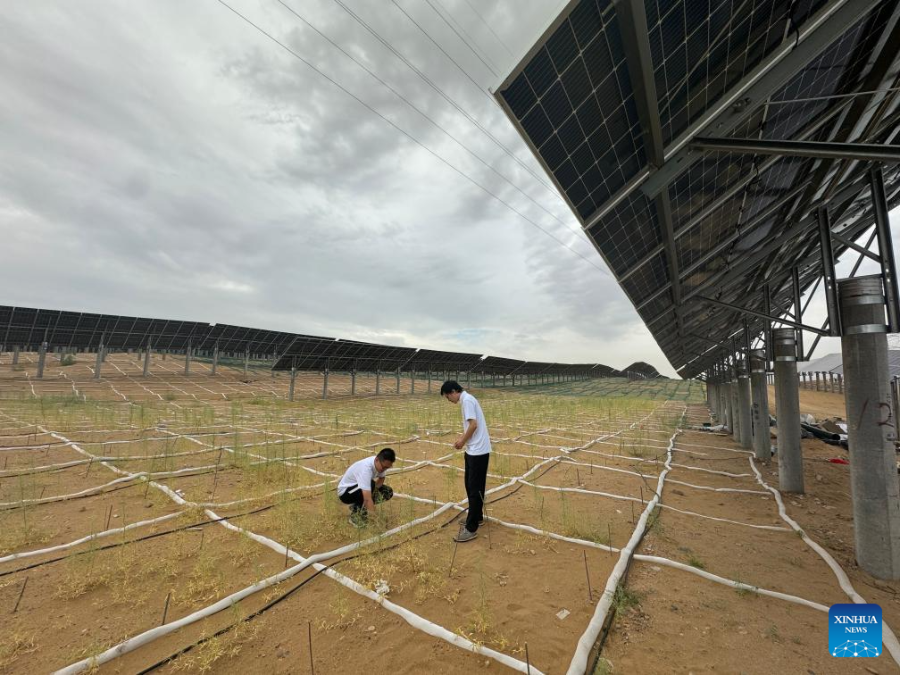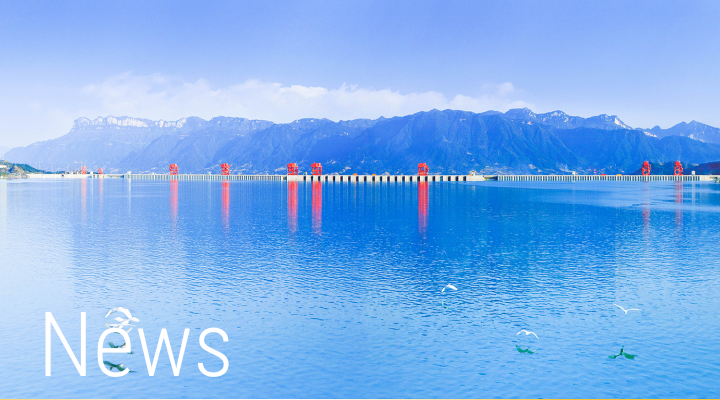Boosting farmers' incomes with solar panels
From:
Date: 2024-08-31

This photo taken on July 24, 2024 shows the Kubuqi Desert Ordos Central-Northern New Energy Base project located in Dalad Banner, north China's Inner Mongolia Autonomous Region. (Xinhua/Wang Jing)
HOHHOT -- Viewed from above, 196,000 blue solar panels form a dynamic silhouette of a horse, galloping through the Kubuqi Desert.
Strolling around the solar power station in Chaideng Village, Ordos City, tourists marveled at the green vegetation and tracking solar panels that spun like sunflowers, and hardly believed that this was once a barren land called the "sea of death".
The solar power station of Junma, which literally means horse in Chinese, is part of the "great photovoltaic wall," an ambitious solar energy desert reclamation project, stretching along the northern edge of the Kubuqi Desert and south of the Yellow River.
Spanning about 400 km in length and averaging 5 km in width, upon completion, this solar marvel is set to have an installed capacity of 100 million kilowatts.
The benefits of solar-powered desert reclamation are substantial. The panels cut groundwater evaporation by 20 to 30 percent, provide shade, and reduce wind speeds, all of which support plant growth. This helps vegetation, like forage grasses that help combat dust and sand, thrive. In arid areas, integrating solar-powered water pumps with drip irrigation has proven to be an effective method for greening desert landscapes.
The "photovoltaic power generation plus desert reclamation" model -- where solar panels generate clean energy above while plants and livestock thrive below -- is also opening new income opportunities and transforming local livelihoods.
Locals are finding various ways to boost their income, such as leasing their desertified land, participating in project construction, and engaging in contract farming. New energy and ecological management companies are encouraged to hire local farmers and herders during both the construction and operation phases.
Li Kai, an official with Dalad Banner Energy Bureau, highlighted the Kubuqi Desert Ordos Central-Northern New Energy Base project as a notable example. In 2023, the project installed 2.18 million solar panels and employed over 3,000 workers, most of whom were local farmers earning between 300 (about 42 U.S. dollars) and 500 yuan per day.
Solar energy desert reclamation projects typically feature a protective forest system established around the photovoltaic power station, combining grass grid sand barriers (using materials like wheat straw, rice straw, and reeds arranged in grid patterns to mitigate wind erosion and retain moisture) with sand-fixing flora to better keep the shifting sands in check.
Wang Ming is a farmer in Pingyuan Village, Dalad Banner, who relies on agriculture for his livelihood. In the past, his annual income was only a few thousand yuan. However, the sand control and afforestation work at the new energy base has provided him an extra income source, increasing his annual earnings by nearly 10,000 yuan.
This spring, he spent nearly a month supporting the construction project, managing over 30 workers and several machines.
"I now have stable work right on my doorstep. I'm really happy," Wang said.
He also mentioned that the project is set to install 8 million kilowatts of solar power. To him, sand control and tree planting offer stable employment.
The city of Ordos, with vast sunflower fields, previously faced challenges with disposing of post-harvest straw. Inner Mongolia Three Gorges Mengneng Energy Co., Ltd., developer of the Kubuqi Desert Ordos Central-Northern New Energy Base project, has turned this challenge into an opportunity by using the straw to build sand barriers as part of their solar-powered desertification efforts.
Each year, the company buys large quantities of sunflower straw from local farmers, using it to combat desertification. This eco-friendly solution also provides an additional income stream for the local farming community.
Liu Tianyun, deputy director of the forestry and grassland bureau of Ordos, said that by 2030, the "great photovoltaic wall" project will provide 50,000 stable jobs, increase average income per capita by over 20,000 yuan annually, and boost the annual output of the ecological industry by 1 billion yuan.
?
All Copyrigh
By China Three Gorges Corporation
Reprinting or mirroring is strictly prohibited without written authorization,
and offenders will be held liable.















